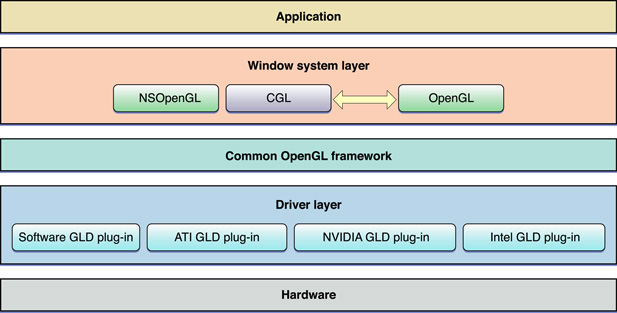Originally posted by Scali
View Post
Announcement
Collapse
No announcement yet.
Valve's L4D2 Is Faster On Linux Than Windows
Collapse
X
-
Common sense, isn't it?Originally posted by Khudsa View PostThat's something I don't know, that osx have the same codebase.
Why would nVidia maintain a separate codebase for OS X, when most of it is the same as for the other OSes? (And if anyone thinks that Apple or Microsoft write their own drivers: n00bs)
So back to my question: why would linux be any different from OS X, given that they both use the same OpenGL codebase?
Comment
-
Well, I know that windows and linux have the same codebase but I never heard anything about osx, and going on it's own opengl version and not following that the driver support don't help in that matter. It's common sense that the driver is made by nvidia and maybe apple puts some layer or something like that.Originally posted by Scali View PostCommon sense, isn't it?
Why would nVidia maintain a separate codebase for OS X, when most of it is the same as for the other OSes? (And if anyone thinks that Apple or Microsoft write their own drivers: n00bs)
So back to my question: why would linux be any different from OS X, given that they both use the same OpenGL codebase?
Comment
-
Well, it's right there in nVidia's own docs. In the exact same sentence that also explains that Windows and linux share the same codebase... So how could you (or anyone else) possibly have missed that? Selective reading much?Originally posted by Khudsa View PostWell, I know that windows and linux have the same codebase but I never heard anything about osx
The difference is mainly that afaik only Apple distributes the drivers, instead of just downloading the latest ones directly from nVidia.Originally posted by Khudsa View Postand going on it's own opengl version and not following that the driver support don't help in that matter. It's common sense that the driver is made by nvidia and maybe apple puts some layer or something like that.
Aside from that, Apple has some custom extensions (then again, so do X and Windows in the form of GLX and WGL), and Apple wants to keep the OpenGL version the same across all vendors, to avoid compatibility issues. So their OpenGL versioning is lowest-common-denominator pretty much. Even though nVidia and AMD have OpenGL 4.2 support in their codebase, they only expose version 3.2 on OS X (but they do expose their extensions).
But again, that's still plenty for a 10-year old DX9 game.
Comment
-
Because OGL implementation is shared between all manufacturers. Check fig. 1-5 https://developer.apple.com/library/...1987-CH208-SW1Originally posted by Scali View PostCommon sense, isn't it?
So back to my question: why would linux be any different from OS X, given that they both use the same OpenGL codebase?
The common OpenGL framework layer is the software interface to the graphics hardware. This layer contains Apple's implementation of the OpenGL specification.
Comment
-
I guess you missed the part where they explain the driver layer:Originally posted by kwahoo View PostBecause OGL implementation is shared between all manufacturers. Check fig. 1-5 https://developer.apple.com/library/...1987-CH208-SW1
That's where the actual hardware-accelerated vendor driver plugs in. Which is what you'd normally be using under OS X. Apple does provide a software implementation as a fallback, but it is not suitable for playing games like L4D.Originally posted by AppleThe driver layer contains the optional GLD plug-in interface and one or more GLD plug-in drivers, which may have different software and hardware support capabilities. The GLD plug-in interface supports third-party plug-in drivers, allowing third-party hardware vendors to provide drivers optimized to take best advantage of their graphics hardware.
They even drew you a picture:
 Last edited by Scali; 04 August 2012, 07:40 AM.
Last edited by Scali; 04 August 2012, 07:40 AM.
Comment
-
Is there anyone with interest in replacing OpenGL(Linux or not)?? In case there is such a big demand for D3D on Linux they can write a State tracker and be done with it. Can't they??Originally posted by elanthis View PostIt would still be so much nicer if someone would just publish a replacement API for OpenGL that worked more like any other API designed in the last 15 years. And did so without tethering it to the clusterfuck that is Khronos. And spent time integrating Mesa's software renderer into a steppable shader debugger. Linux with Gallium is the perfect place for this since you can write a new API and get direct hardware acceleration without needing to wait for any hardware vendors to get on board. Just sayin'. Nudge nudge.
Comment
-
I believe they already did a D3D tracker as a proof-of-concept, using Gallium to build a Windows driver.Originally posted by 89c51 View PostIs there anyone with interest in replacing OpenGL(Linux or not)?? In case there is such a big demand for D3D on Linux they can write a State tracker and be done with it. Can't they??
That should easily be portable to linux.
But the biggest problem is that most linux drivers don't make use of Gallium. Certainly not the only two drivers that really matter: AMD's and nVidia's binary drivers.
Comment
-
What I pointed out however, is that people had been playing Steam games on Mac through Bootcamp, and because of the poor quality of the Mac port, many of them continue to use Bootcamp rather than the native Mac versions.Originally posted by AJSB View PostThere was and there will not be any major migration to MAC for the simple reason that Apple (at least here in my country) was looked at as an Elite Hardware vendor with very high prices for what you get.
They already had the Mac hardware to begin with.
Comment

Comment